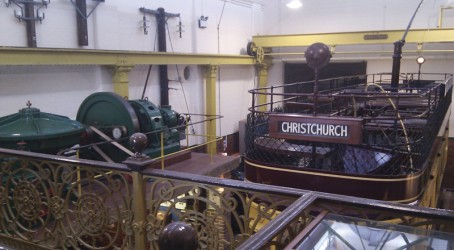Museums
The historic town of Christchurch, near the New Forest, is well-known for its priory church and old inns, but few are aware that it also harbours an Aladdin’s cave of electrical artefacts.
The Museum of Electricity, run by Southern Electric, is tucked away in the last surviving Edwardian power station in Britain. Most of the ground-level galleries are in what was once the main generating hall.
Bargates power station first came to life in 1903 when it served Christchurch and the surrounding area. Later it also supplied power for the trams that ran from Poole to Christchurch. By the 1930s the Bournemouth area was linked up to the national grid, and the station was no longer needed in its original capacity. For the next few decades it housed a substation, but by the 1970s the entire structure was converted into a museum.
Nestled towards the back of the building is a magnificent Belliss & Morcom/GEC steam generating set. It is similar to the two generators previously installed at the power station to supply electricity to Bournemouth and Christchurch.
Coloured rings in the brickwork behind the exhibit show where steam once entered the main hall from the boiler room next door. Coal to fire the large boilers came from Christchurch railway station, just half a mile down the road.
An example of a mercury arc rectifier sits in the corner. This one used to supply direct current for the lifts in Bournemouth’s shops.
Proudly taking centre stage in the hall is the No. 85 tram, the last remaining complete car from the Bournemouth fleet. The cars were known as Dreadnoughts and this one remained in service until the local trams were replaced by trolleybuses in 1936.
At the rear of the tram is an interesting example of an under-street cable holder. Bournemouth council insisted on the under-street pick-up system to avoid having unsightly poles and overhead cables draped about the pretty town centre. Rubbish and rainwater frequently collected in the ducts, so the impractical system was abandoned in 1911.
Upon climbing a cast-iron staircase visitors find themselves on the control landing. It’s from here that the power station’s control engineer would have been able to survey the goings on in the hall downstairs.
Cracks and bolts of electricity can be heard emanating from the demonstration room, which was once the battery room. Here, children and adults alike can have fun while learning about how electricity is generated, as well as how in the past it was used and abused to treat medical conditions such as insomnia.
Modest displays with early toasters, kettles, vacuum cleaners, washing machines, cookers, TVs, tape recorders and computers line the walls of adjacent galleries.
But it is the industrial gallery that deserves extra attention. This exceptional collection of historic equipment includes generators, meters and rotary converters. There’s a Mather & Platt rotary converter that was once used to convert alternating current to direct current, and a Hopkinson-Knapp generator built in 1893.
Other notable exhibits include the Highfield Booster, used in the early 1900s when it was standard practice to close down boilers and dynamos during periods of low demand, such as at night. The machine was responsible for keeping the current constant when the supply was being provided by the batteries.

5 things to see
Dreadnought No. 85 tram
The last remaining car from Bournemouth’s tram fleet.
Belliss & Morcom steam engine
Two generators such as this one were once used to supply electricity to Christchurch.
Mather & Platt rotary converter
Rotary converters were gradually replaced by mercury arc rectifiers.
Hopkinson-Knapp generator
This generator is of a similar type to those once used in Brighton power station.
The demonstration room
Get an educational jolt from electrical experiments.